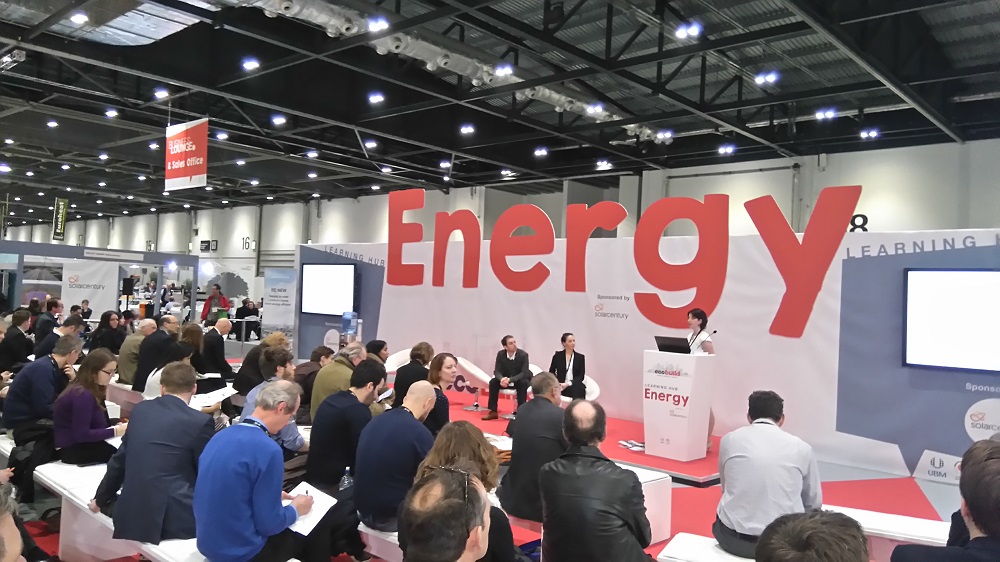Ecobuild 2016 - Making the business case for large scale retrofit investment
Designing Buildings Wiki went to the Excel Centre for day one of EcoBuild 2016, the UK’s largest construction and energy event.
The rationale for domestic retrofit is as important as ever. Retrofit not only cuts carbon emissions, it makes it cheaper to keep homes warm and helps to overcome poor ventilation and damp, and improves health. The seminar, chaired by Kore Mason, programme manager for the Greater London Authority, explored the business case for energy efficiency works as well as how to identify and manage the technical risks.
George Simm, energy consultant at Capita, began by asking why exactly retrofit needs a business case? The main reasons, he said, where to show clearly how benefits can be maintained, ensure projects are deliverable, gain senior level buy-in, and help plan future phases.
According to Simm, in a time of unprecedented business pressures, every funding plan for housing developers needs to be justified, and that retrofit is still seen as being a ‘nice to have’ rather than a necessity. It is vital that the wider benefits are demonstrated, such as the generation of local employment and the increase in Net Present Value of the project that often results.
Making a strong case requires:
- Good understanding of drivers and targets.
- Ability to articulate the full range of benefits beyond tenant welfare.
- Sound plan for funding, procurement and delivery.
Simm said funding is still available from a range of sources, but projects that can demonstrate a return have the best chance of success. He was confident that organisations willing to develop the case for retrofit would see benefits in the future, and cited the Energiesprong organisation currently aimed at social housing providers as an example.
Lisa Pasquale, director of Six Cylinder, spoke about managing the risks of retrofit. She cited the most common problems as: underventilation and condensation, air leakage, mould issues, interstitial condensation, and overheating. Not to mention the negative impact on profit and reputation for housing associations having to deal with remedial works.
She said that to mitigate the risks, it was important to understand the retrofit process, and modify and strengthen it according to each individual project.
On the question of why retrofit can go wrong, Pasquale made the following diagnoses:
- Overambitious performance gains claimed by designers and suppliers.
- A lack of robustness of detailed design.
- Fragmented procurement and delivery (lack of overall responsibility and ownership).
- Poor construction sequencing and commissioning.
- Inadequate handover and user guidance.
She suggested that between each of the four retrofit processes – assessment, design, installation, operation – there needed to be ‘retrofit watch points’ to help alleviate problems due to poor integration between trades, such as inappropriate substitutions to materials and products.
On the issue of post-occupancy evaluation, she stressed the need for monitoring fuel use, occupant surveys, air permeability testing and thermographic surveys. She also said it was important to take account of the fact that residents may have been underheating their property prior to retrofitting due to fuel poverty.
While the green building industry may have suffered substantial setbacks at the hands of the Conservative government, there are still signs that progress is being made. Although some members of the audience expressed concerns that it was too little and too slow, the speakers seemed confident that the business model for retrofit will become more coordinated as bigger firms start to get involved, working with smaller ones and increasing numbers of projects.
[edit] Find out more
[edit] Related articles on Designing Buildings Wiki
- Allowable solutions for zero carbon buildings.
- BRE and Willmott Dixon project to retrofit of a 1920s semi-detached house.
- Building Places that Work for Everyone.
- Ecobuild 2016 - What makes good housing?
- Ecobuild 2016 - What makes housing fit for the future?
- Ecobuild 2017.
- Green building.
- Home Quality Mark.
- How to deal with retrofit risks.
- Leadership in Energy and Environmental Design LEED.
- National Refurbishment Centre.
- Nearly zero energy buildings.
- Retrofit.
- Retrofit coordinator.
- The Each Home Counts report and traditional buildings.
- Zero Bills Home.
- Zero carbon homes.
IHBC NewsBlog
Purcell’s guidance on RAAC for Listed Buildings in England & Wales
The guidance specifically focuses on Reinforced Autoclaved Aerated Concrete (RAAC) in listed buildings.
IHBC Membership Journal Context - Latest Issue on 'Hadrian's Wall' Published
The issue includes takes on the wall 'end-to-end' including 'the man who saved it'.
Heritage Building Retrofit Toolkit developed by City of London and Purcell
The toolkit is designed to provide clear and actionable guidance for owners, occupiers and caretakers of historic and listed buildings.
70 countries sign Declaration de Chaillot at Buildings & Climate Global Forum
The declaration is a foundational document enabling progress towards a ‘rapid, fair, and effective transition of the buildings sector’
Bookings open for IHBC Annual School 12-15 June 2024
Theme: Place and Building Care - Finance, Policy and People in Conservation Practice
Rare Sliding Canal Bridge in the UK gets a Major Update
A moveable rail bridge over the Stainforth and Keadby Canal in the Midlands in England has been completely overhauled.
'Restoration and Renewal: Developing the strategic case' Published
The House of Commons Library has published the research briefing, outlining the different options for the Palace of Westminster.
Brum’s Broad Street skyscraper plans approved with unusual rule for residents
A report by a council officer says that the development would provide for a mix of accommodation in a ‘high quality, secure environment...
English Housing Survey 2022 to 2023
Initial findings from the English Housing Survey 2022 to 2023 have been published.
Audit Wales research report: Sustainable development?
A new report from Audit Wales examines how Welsh Councils are supporting repurposing and regeneration of vacant properties and brownfield sites.
















